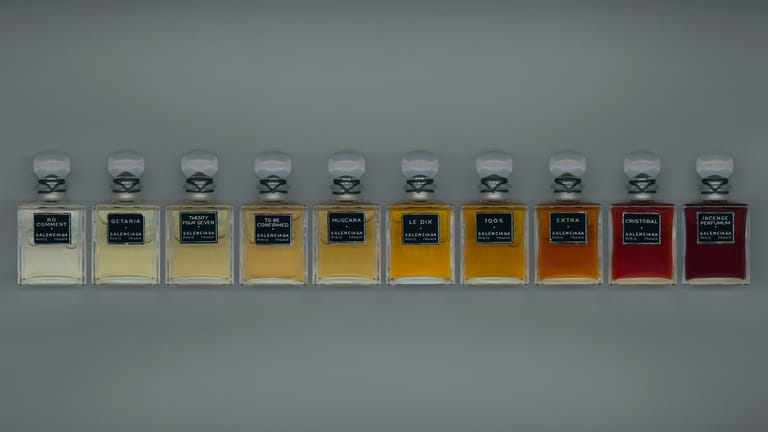Beyond the Tariff Turmoil: How C-Beauty Can Thrive Amid US-China Trade Tensions
By
Charlie Gu

Published on
April 18, 2025

Jingzhi Voice brings thought leaders, industry pioneers, and cultural influencers together to decode key trends, challenge conventions in China, and offer forward-thinking ideas that shape the future of jingzhi (精致) and beyond.
In early April 2025, the United States significantly escalated its trade measures against China. It imposed sweeping tariffsthat profoundly affect various industries, including the beauty sector. On April 9, 2025, President Donald Trump announced that the US would increase tariffs on Chinese imports to 125 percent, up from 104 percent. This increase intensifies the ongoing trade war between the two nations. At the same time, the US removed the small package trade loophole, known as the de minimis exemption, which let items under $800 from China and Hong Kong enter the US duty-free. Effective May 2, 2025, low-value packages from China and Hong Kong will incur a 90 percent tariff or a flat fee of $75 per item, increasing to $150 after June 1.
In retaliation, China unleashed an 84 percent tariff on US goods, intensifying the clash and roiling global markets. These developments have significantly disrupted international trade. Chinese companies selling on platforms like Amazon are now considering price increases or exit strategies from the US market due to untenable costs.
While these newly imposed tariffs will impact businesses on both sides, they particularly underscore the urgent need for Chinese beauty brands (C-Beauty) to reassess their international strategies, as the increased costs threaten their competitive positioning in the US beauty market. The significant increase in tariffs and the removal of the de minimis exemption have effectively blocked traditional paths for exporting low-priced products directly to the US. This necessitates a shift towards more resilient and adaptive business models that empower C-Beauty brands to navigate the fierce economic landscape reshaped by tariffs.
Brand-First Globalization, Not Product Exportation
Historically, many Chinese brands succeeded internationally by leveraging competitive pricing strategies—essentially competing on cost rather than brand equity. The recent tariff hikes have shown this approach to be highly vulnerable. C-Beauty brands must pivot towards brand-driven globalization strategies to survive and thrive internationally. Their past reliance on cost-based competition has proven unsustainable in the face of punitive tariffs. It is compelling brands to foster a stronger identity that resonates with consumers amidst rising prices.
This involves significant investment in brand building, elevating perceived value, and establishing emotional connections with international consumers beyond price consideration. High brand equity provides a buffer against tariff impacts due to increased margins, thus equipping C-Beauty brands with greater resilience in turbulent geopolitical landscapes.
American skincare brands, particularly luxury brands, illustrate this advantage clearly. Tariffs China imposes on American products are calculated based on sell-in prices to distributors, often leaving significant margins intact for premium brands. Consequently, it becomes even more crucial for Chinese brands to develop premium positioning and higher brand equity to match their international counterparts.
Global Supply Chain Diversification and Localized Deployment
The tariff war has clearly demonstrated the risks inherent in single-source supply chains heavily reliant on China-based production. C-Beauty brands need a globally diversified supply chain strategy that reduces dependency on one region and mitigates geopolitical and regulatory risk. Establishing production facilities or forming strategic OEM partnerships in areas outside China—such as Southeast Asia, Mexico, or even Europe—helps to reduce tariff exposure while strategically positioning C-Beauty brands for smoother market entry and greater resilience. Moreover, localized deployment of products tailored specifically for different regional markets enhances consumer resonance and operational agility.
A prime example of this strategy is Proya, which not only attended Cosmoprof Worldwide Bologna to engage with global suppliers but also established an overseas innovation center in Paris, thereby building relationships with European supply chain partners. Such efforts enable local innovation and manufacturing capabilities that position Proya on the global stage advantageously.

Geographic Diversification and Strategic Market Selection
C-Beauty brands can also strategically pivot to alternative high-potential markets in response to increasing tariff barriers and regulatory challenges in the US mature consumer markets with cultural similarities to China, such as Japan, offer sophisticated consumers receptive to culturally resonant beauty products. Emerging markets with rapidly expanding middle-class populations, such as the Middle East, present unique growth opportunities with less saturated competitive landscapes. Additionally, markets in South America provide ample opportunities for Chinese brands to establish first-mover advantages and a substantial market presence due to the limited presence of competitive beauty brands.
Cultural Narratives and Brand Philosophy as Cornerstones
Successful global brands often anchor their identity in powerful cultural narratives and distinct brand philosophies that resonate universally. For many traditional C-Beauty brands, their competitive edge often relies on supply chain efficiencies, not strong brand equity. In recent years, a new generation of C-Beauty brands, like Florasis, Timage, and Herbeast, have been rewriting the narrative by effectively communicating their cultural heritage, Chinese beauty philosophies, and modern interpretations of traditional practices to foster greater global appeal. This new cohort of C-Beauty trailblazers understands that showcasing their cultural heritage is essential for long-term success.
When communicated thoughtfully, these narratives differentiate Chinese brands from global competitors and cultivate deeper consumer engagement. Amid rising nationalism and shifting consumer sentiments influenced by geopolitical tensions, brands rooted in authentic cultural stories with universal appeal stand a better chance of winning hearts and minds globally.
Florasis’s recent expansion into Tokyo’s prestigious Ginza district exemplifies this strategic approach. By highlighting its rich cultural heritage alongside an astute understanding of Japanese culture, Florasis successfully resonated with local consumers, demonstrating how powerful storytelling and cultural sensitivity can significantly enhance brand appeal internationally.

Accelerating Globalization through Investment, Acquisitions, and Strategic Partnerships
To rapidly build global footprints, C-Beauty brands should explore aggressive investment strategies including mergers, acquisitions, and strategic partnerships. Acquiring established brands or production capabilities in key overseas markets can expedite market penetration by instantly providing credibility, infrastructure, and consumer trust. Investments and strategic partnerships with local entities reduce regulatory barriers and facilitate smoother market integration. Constructing a global brand matrix through strategic financial operations positions Chinese brands as legitimate and competitive global players.
The acquisition of RéVive, an American luxury skincare brand, by SYoung Group last October is an illustrative example. This strategic move has quickly elevated SYoung’s global profile, enhancing market credibility and consumer trust. Such investment and acquisition activities will allow companies like SYoung to find synergy across the portfolio brands and leverage the distribution channels and local knowledge in different regional markets outside China.
The recent escalation in the US-China trade war should act as a catalyst for C-Beauty’s strategic transformation. By shifting toward high-value brand building, diversified global supply chains, powerful cultural storytelling, and aggressive investment-led global expansion, Chinese beauty brands can transcend current challenges, turning geopolitical turbulence into an opportunity for profound industry growth.












